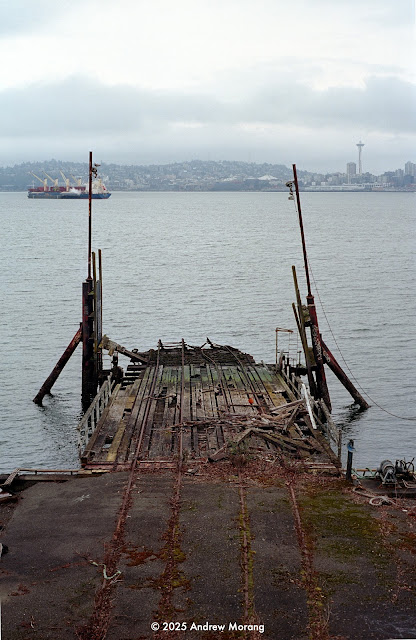I continued my September 2024 road trip through eastern Washington with a stopover in Spokane.
Spokane is the big city of eastern Washington. It has a beautiful setting on the Spokane River, with waterfalls and a riverfront park. It is a major rail and road junction serving eastern Washington and western Idaho. Decades ago, I drove past Spokane several times on Interstate-90 but do not recall pulling off and visiting the downtown.
For my 2024 trip, an old college friend generously offered me a place to stay in his house. He lives in a turn of the century house near Gonzaga University. But where to eat breakfast? Why, at the Hillside Inn Cafe.
 |
| Morning at the Hillside Inn Cafe (digital file) |
The cafe is a cheerful place with friendly staff and patrons, and good eggs and bacon. The checked tablecloths reminded me of
Durgin Park Restaurant in Boston, now sadly gone forever.
My friend's house is only a block from the Spokane River Centennial Trail, which follows the river for over 30 miles. I did not have a bicycle, so I walked downtown along the river.
 |
| Iron Bridge over the Spokane River |
 |
| Nice VW bus, Gonzaga University |
 |
| Upper Falls of the Spokane River, downtown Spokane |
 |
| Monroe Street Bridge over the Spokane River (Samsung digital file) |
The Falls downtown are spectacular, especially on a cheerful sunny day. I did not know that Spokane had such a scenic geologic setting. The Monroe Street concrete arch bridge is an impressive edifice.
 |
| Construction of Monroe Street bridge, August 3, 1911 (from the Library of Congress) (click to enlarge) |
 |
| Rear of Monroe Street commercial buildings |
 |
| Monroe Street commercial buildings |
A few old-time commercial buildings remain. But the city looks prosperous and clean. I could not find grunge.
 |
| Health lunch |
By midday, I was hungry. Where to eat healthy food? Why, at the Method Juice Cafe. Mmmm, veggies and nuts. And a bottle of green health juice, that thick liquid made from squashed kale and anything else they can find to toss into the blender. By the time I was done, I felt like a goat, and walked back along the river past Gonzaga University (with a stopover at a coffee shop).
Next update: heading west into central Washington.



















































